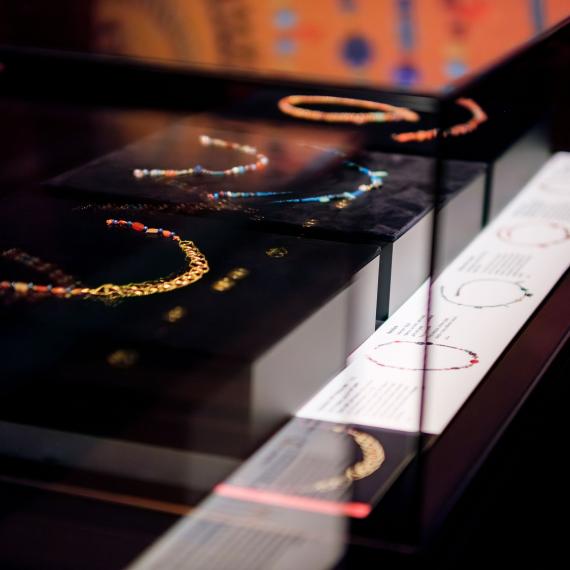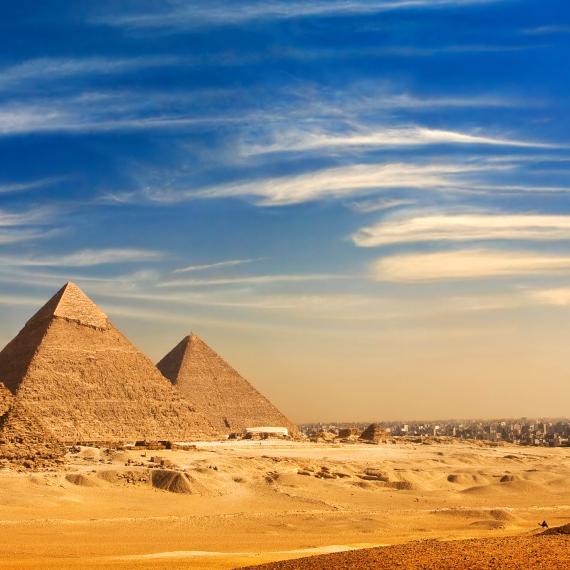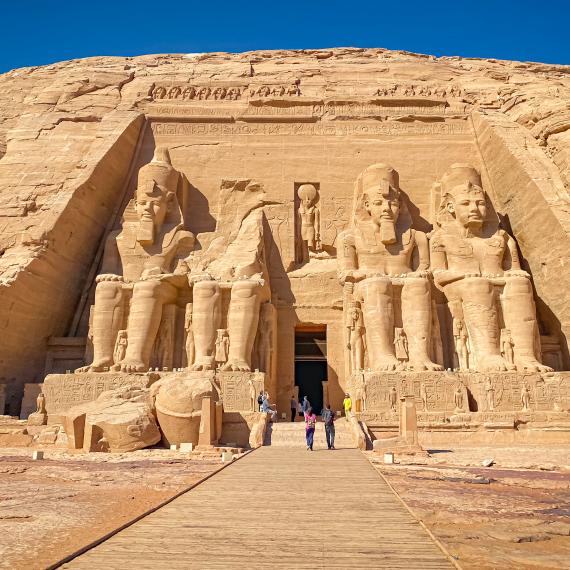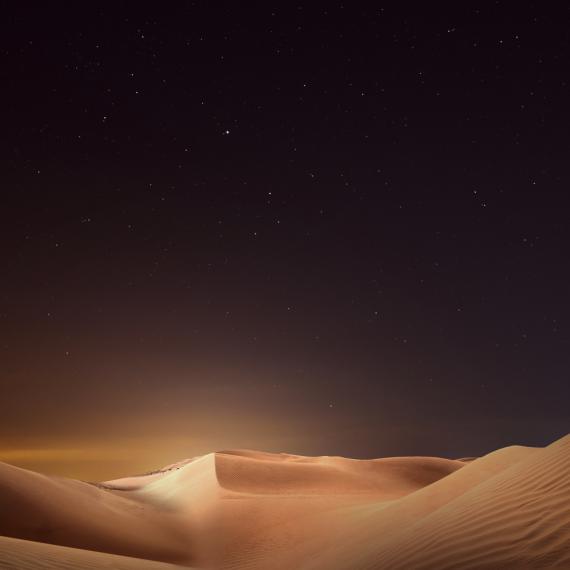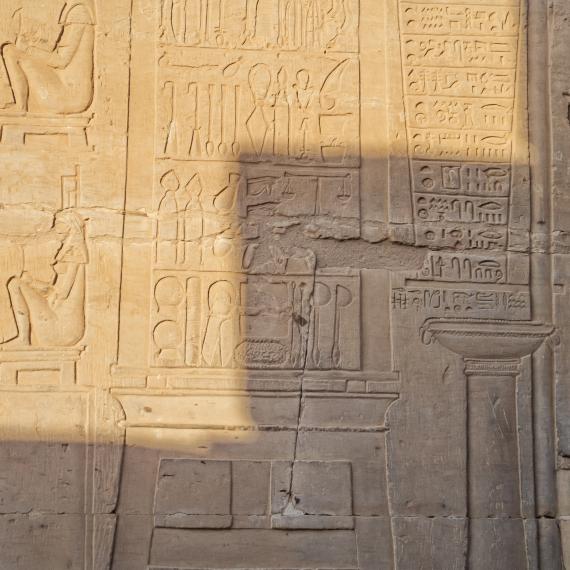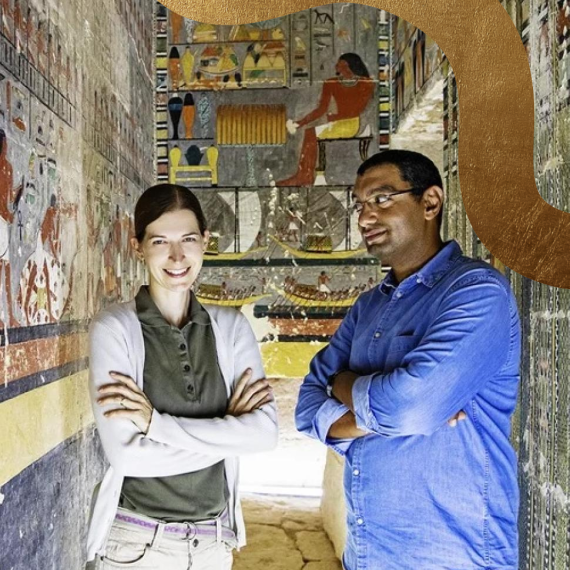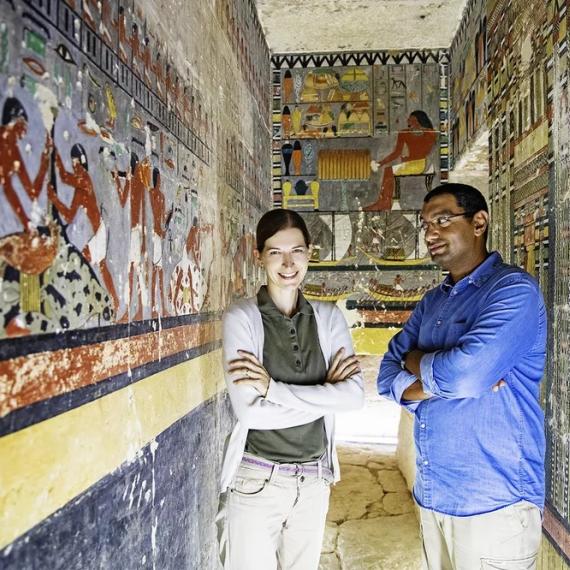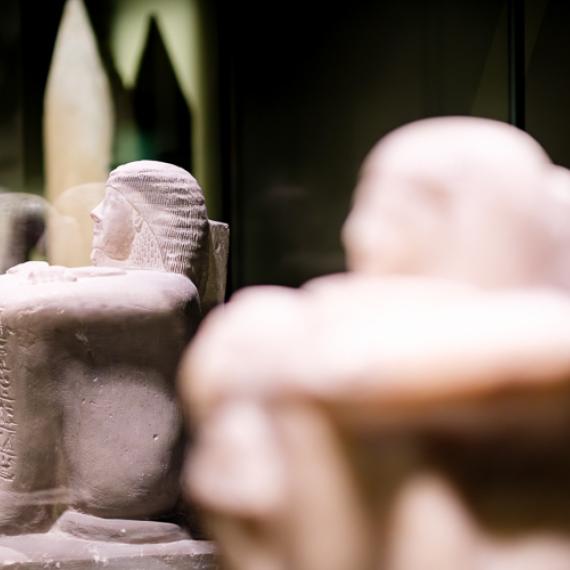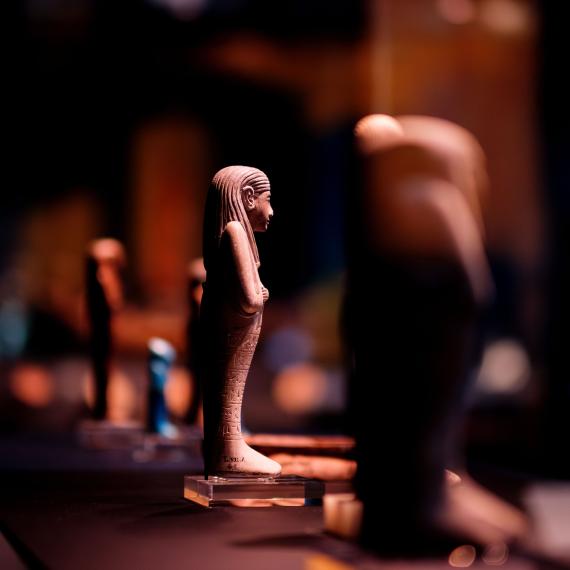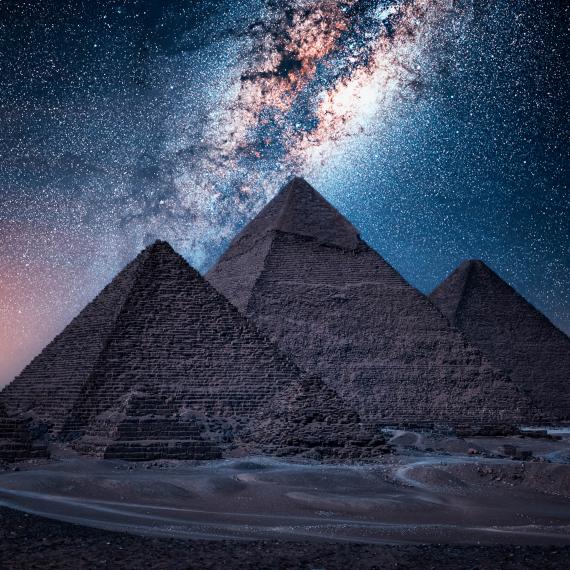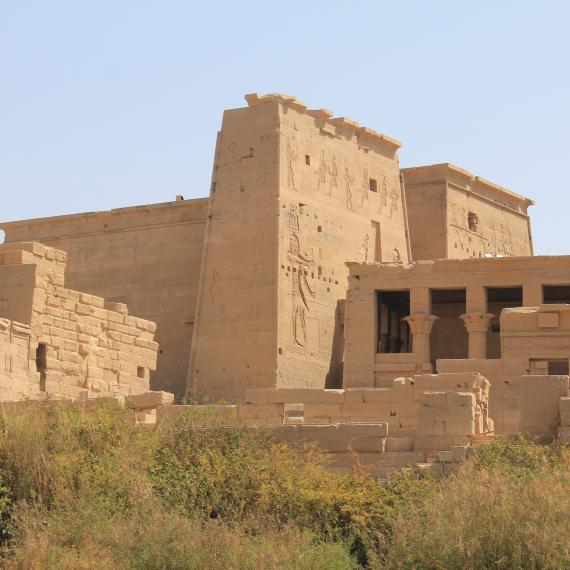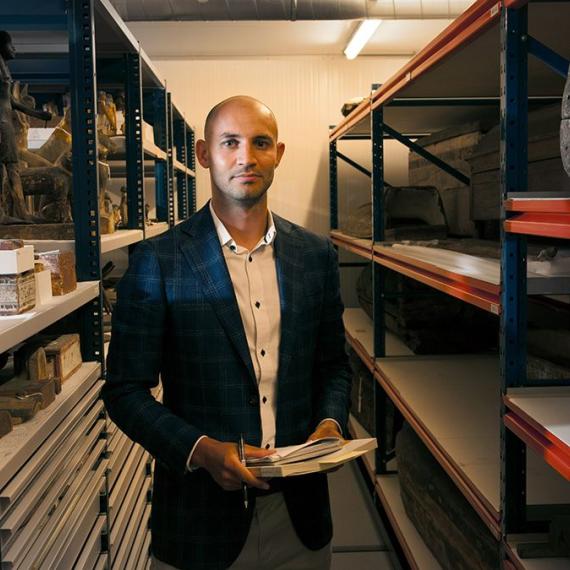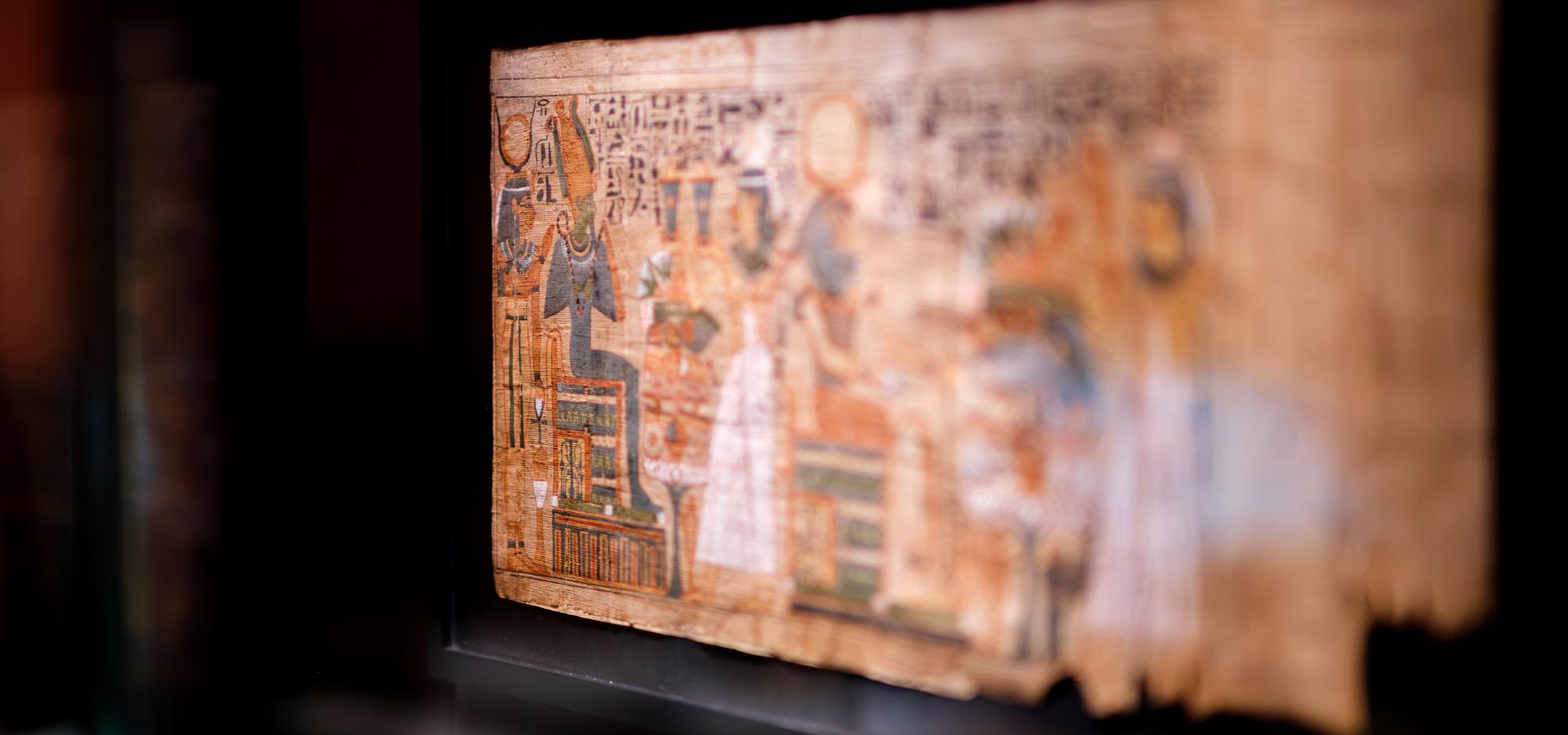
Ancient Egyptian Mythology by Dr Jasmine Day
Discover Egypt’s ancient legends of creation, death and resurrection. Tales of Ra, Osiris, Isis and Horus will unlock the meanings of the art, religion and funerary practices of ancient Egypt.
Dr Jasmine Day, anthropologist and Egyptologist, is an expert on Egyptian mummies and the author of The Mummy’s Curse: Mummymania in the English-speaking World. She appeared in TV’s Egypt’s Unexplained Files.
-
Episode transcript
Intro:
Welcome to the Western Australian Museum Boola Bardip Talks Archive. The WA Museum Boola Bardip hosts a series of thought provoking talks and conversations, tackling big issues, questions and ideas and is delighted to be able to share these with you through the Talks Archive. The Talks Archive is recorded on Whadjuk Nyoongar Boodja. The Western Australian Museum acknowledges and respects the traditional owners of their ancestral lands, waters and skies.
Event MC:
Good evening everybody and welcome to the West Australian Museum Boola Bardip. Before we get started with our guest speaker it tonight, I just want to take a moment to acknowledge the lands on which we are gathered on and learning here today and acknowledge the Whadjuk people of the Nyoongar nation. May we pay our respects to their elders past and present.
Our guest speaker for tonight is Dr. Jasmine Day, a very talented Egyptologist and anthropologist. Please make them feel welcome.
Dr Jasmine Day:
Okay. Hello and thank you very much for coming along tonight. It's been really great that these talks are well patronized and some of them are being presented by our friends at the ancient Egypt Society of Western Australia. I'm the president of the Ancient Egypt Society, and we've got some fliers here if you're interested the in to pick up a flier. It's a group for anybody who's interested in Egyptology. You don't have to have any particular level of knowledge if you're interested, even if you haven't been to Egypt, you're very welcome to join us. It's a social club as well as educational. And we have a monthly lecture at Citywest Lotteries House in Perth.
So, yes, I'm an Egyptologist. I'm also an anthropologist. An anthropologist is a person who studies culture, it's a very broad area. It's hard to know where to begin, but my area I was interested in ancient Egypt, but I wanted to approach it from a different angle, not just pure Egyptology, but looking, looking at how people have looked at ancient Egypt. And I'm very interested in mummies, so I ended up writing an anthropology doctoral thesis at UWA years ago uh, and, uh, on ancient Egyptian mummies in Western popular culture, otherwise known as mummy mania. At the end, I'll show you a picture of my book, in case you're interested to read that it's sort of written for a public audience, but I wanted to talk about how mummies are portrayed in popular culture and the impact it has on how people view mummies in museums and the ethics of displaying mummies. I was very chuffed because at the beginning of this wonderful exhibition, which is from one of the biggest Egyptian collections in the world and in Europe, the RMO, Rijksmuseum van Oudheden in Leiden in the Netherlands, which I've been to. At the beginning of this exhibition, I met the curator, Dr. Daniel Soliman, and I introduced myself and I said,
“I knew both of your predecessors at the RMO. I visited them and they visited over here”
and he said,
“Oh yes, I know you. Your work is quite famous on Mummy mania. And by the way, we've used your work on Mummy ethics to help design the Mummy exhibition in the display here.”
So I was very chuffed by that. So that moment when you realize that, you know, thirty years of work actually paid off.
So yes. Okay. So that's just a little bit about me and my background there. But what I want to talk about tonight actually is, of course, Egyptian mythology. This is a subject that you sort of need to know in order to understand Egyptian objects, Egyptian art, Egyptian religion. A lot of Egyptian art and even the hieroglyphs just look like gobbledygook if you don't know what they mean. It's just a bunch of random things. It seems to be about snakes, a bit about birds, and mostly about snakes. What's with that? And scarab beetles? What's with that? I'll tell you tonight about the scarabs. So if you know the stories behind the myths, story stories behind the art, I should say, then suddenly all the art starts to fall into place and you understand what you're looking at. It's an incredible experience to walk through an exhibition like this and be able to say,
“Oh, yes, I know what that is. I know what that is. Yeah, I know what's going on on that stelae, Yes.”
In the same way that you could walk down a city street and look at the billboard advertising and just know what everything is. I realize sometimes I've grown up in two cultures in a way, because I've been studying this stuff and looking at it since I was eight years old and it really has sort of gone into my mind. Okay, so here's a papyrus. This is one of the books of the dead, as they're often called, the book called The Book of the Dead. It's actually called The Book of Coming Forth by Day. What does that mean? I'll tell you in a little while.
So Egyptian mythology is actually a fusion of a number of different religions. When the Nile was settled by milli, uh… many villages up and down the Nile in over five thousand years ago, maybe ten thousand years ago, the people who came there each had their own individual God or goddess.
And when the kingdom united, they put all those deities together. So instead of having a religious war, my gods better than your God, they simply put them all together. But there are four basic different versions of Egyptian mythology. Four cosmogonies and a cosmogony is a legend of how the world was created by this God or that God.
And the most popular one that you often see referred to is what we call the Heliopolitan cosmogony. It's stories told by the priests of Heliopolis, which is now a suburb of Cairo, and they did actually find the temple of Ra there. Heliopolis. Helios, after which the city was named by the Greeks, was the Greek sun. God, why did they name the city after the Greek sun god when the Greeks came to Egypt? Because it was originally the city of Ra, Ra, the Egyptian sun God. So Heliopolis, the city of Ra and his temple is there. It actually exists. So he was said to have created the world as we’ll see. There are other myths about how the God of Memphis, when Memphis was the capital of Egypt, they said, Ah, but our God created the world and he Ptah, was the craftsman. And then Hermopolis was the city of Thoth. Or Djehuty (pronounced: Jah-hoti) is his proper name, the Egyptian name for this God. Djehuty the scribe God, the God with the head of the ibis, we might talk about him later on. So he was said to have created the world in some of the myths. And the other myths said that Amun the hidden one is his name. Amun the hidden one, he is the God of Thebes. From the time when Thebes today, Luxor in Egypt, when that was the capital of Egypt and Amun is a God who was extremely well known. He became very powerful during the new kingdom of Egyptian history, and he's commemorated, for example, in the name of a certain pharaoh called Tutankhamun. Okay. Which means the living image of Amun.
But I'm going to go back to Ra because these are the tales of how Ra and his progeny created the universe and the early adventures in the world that sit down for human beings the right ways to live and the way for the Pharaoh to rule the kingdom. Let's run through our cast of characters before we begin. The first gods of Egypt are often known as the Ennead, the nine gods. We know them, often by the Greek names, which I've got in black here, but in red I put their original Egyptian names. The Greeks came to Egypt, followed by the Romans in later antiquity. But all of these gods had their original indigenous names. There was, of course, Ra in the beginning, some gods, sorry, some myths said that Atum was the creator God. And so when the Atum faction came together and met the Ra faction, they didn't have a war or football match. They just mushed their beliefs together and said
“nah, Atum-Ra”
There's a lot of that in the Egyptian mythology. There's there's Amun-Ra, you know, whichever god is the most powerful, if that gets supplanted by another God, when that God city takes over as the capital of them, they just push them together easy, right?
So Ra had two children, Shu and Tefnut the atmosphere and the moisture. And these are like the building blocks of life at the beginning of the universe. What do you need? You need air, you need water. And of course, who do you marry when there's only two of you? Well, each other. So I say the kids, when I'm explaining this, don't get upset about brothers and sisters getting married. It's not literal. It's a symbol. Okay? It's just a symbol. But then following this symbol and perhaps consolidating power in their families, the Egyptian royalty would often intermarried brothers and sisters or half brothers, half sisters, to keep the bloodline as pure as they could and keep other families out. Anyway, Shu and Tefnut had Geb, The earth. He is a God, not a goddess, God of the earth. Hence he’s green, the colour of vegetation. And then there was Nut (pronounced Newt), his sister and wife, and she was the sky. So she's often shown with her hands and feet at the horizon, bending over the earth. Her body is blue and spangled with stars. She's the sky and the children of the earth and the sky, Geb and Nut are very famous. You may have heard of them. Osiris, Isis, Nephthys and Seth and Osiris and Isis married, and Nephthys and Seth married. But if you look at their original Egyptian names, you can see how they were originally conceived as, as a pair, as a dyad, Ausare and Aset, Nebet-het and Set the male and the female of each pair and a famously Isis and Osiris had a son Horus or Hor or Heru in ancient Egyptian. And depending which ancient myth you believe, which version of its Anubis, the embalming god whom we'll meet later on was the progeny of Nephthys and Osiris when I guess Isis was asleep or something. Something went on there. It depends, other people will tell you the Anubis came from somewhere else. So there's no single version, single right version of Egyptian mythology, it's more like guidelines.
Let's begin our story at the beginning of the universe. Now, the Bible says that at the beginning of the world, God moved upon the face of the waters. And we know that the Bible, parts of the Bible actually were probably inspired. And some parts definitely inspired by things from Egyptian beliefs and mythology. The Bible is kind of like the greatest hits of ancient Middle Eastern mythology mushed together. Sorry, no disrespect, but it does come about. It's kind of like pulling together all the greatest ideas and philosophies that they had, which is why it's so powerful as a piece of storytelling. And here's one of the places it might have come from. In the beginning. There was only the nun, the nothing, the nun, and it was the great waters of chaos with serpents, those symbols of chaos. They were everywhere, swimming around. And just as a lotus or a lily rises above the waters in real life and opens at the dawn. A great lotus came up and when it opened there was a golden child inside. And this was no ordinary child. It was Ra, the creator. And you see him with this little side lock of youth there, meaning his child and his finger to his lips. It's actually based on the hieroglyphs, the child, you know, sucking the thumb, sucking the finger. But here he seems to be paused, about to name something and create it. And so he created Shu and Tefnut, the atmosphere in the moisture as we've seen. And then they created Shu, sorry, Geb and Nut.
Here, by the way, is a lovely piece of jewelry demonstrating how these ideas come together in the art. This is Ra sitting on that lotus emerging from the lotus. He's already wearing a beautiful necklace with a big heavy counterpoint. These necklaces were so heavy that they often needed a second pendant at the back just to hold it and stop it from pulling down, pulling your head down. If you see that on Tutankhamen, he has like the big pendant, and then the counterpoint is on the other side of the necklace.
So also the inlays in this have fallen out, but it would have been very colourful with his little side lock there. And he's wearing a sun disk. So, you know, this is no ordinary child. This is Ra at the moment of creation. And so, as I said, his grandchildren, Geb and Nut, were born. And when they were in love with each other, of course, they were pressed very closely together, the earth and the sky were pressed together.
But Ra wanted to create something and there was no way for anyone or anything to live because the earth and the sky were squashed together. Shu was jealous and he came between them. Their, their father. He was the atmosphere and pushed them apart. And so between the sky and the earth is the air, the atmosphere and the place in which we live, the air we breathe, pushing apart.
So that is an image, by the way, from the side of a coffin. Why put it on a coffin? Isn't that about death? No. Death is followed by resurrection, as we'll see. And so symbols of life and resurrection and eternal life are placed deliberately on things like coffins. And there's beautiful examples in the exhibition and Nut and Ra Sorry, Nut and Geb were separated forever and could always see each other, but could never touch each other again and they were very sad.
Okay, so now I'm going to talk about the solar cycle. What does the sun have to do with scarab beetles? What is this thing about scarab beetles all the time? I thought they were dung beetles. Well, they are, but there's more to it than that. This is interesting. It's a piece of jewelry in the “Musée du Louvre” in Paris, and where I would expect to see an image of Osiris being worshiped and respected by his two sisters. Instead, we see in the middle, Ra as a scarab beetle. So what… again, the Egyptians are smooshing together religions. They took the cult of the sun, of Ra, and the cult of Osiris, the cult of death and resurrection and they smooshed them together and they substituted Ra for Osiris in this image. But again, why is he flying around in a boat?
What's this got to do with it? Well, let's go back to scarabs. Scarabs, you sometimes see things like heart scarabs. There's one in the exhibition, and it has a spell on the bottom, which is to do.. *coughs*.. excuse me, to do with giving the person like a free passport into the afterlife, making sure that they pass the final judgment and can go into heaven. The spell on the bottom is a bit of a cheat. It's saying,
“Oh, my heart……” It was put over the top of the mummy's heart and bound it in place with the wrappings. It says,
“Oh, my heart, my conscience. Please don't tell the gods that I've been naughty. Please don't make my name stink before the judges.”
That's literally what it says and yes, there's a word for stink in Egyptian. Yes, but why use a scarab? You find them all the time. You find little scarabs. Stone carvings of scarabs and stones like steatite or even precious gemstones. You find scarabs moulded in faience. That beautiful blue, greeny ceramic substance. Well, here is a real scarab over the top and you can see those funny little front feet. What are those for? Well they’re for scooping dinner when your dinner is animal poo. These guys are unfortunately at the bottom of the food chain, and so they eat animal droppings. But it's all right. It's nutritious for them. So they climb over it like this and paste it into a ball and kick it away and get some takeaway food.
This is how they do it. And they come along in the wet season in Africa, when the animals are congregating around the waterholes and dropping dung. Then when the animals go away, as is the waterholes of dried up in the dry season, the scarabs are now hibernating underground with their balls of dung. They can eat it and they can lay their eggs in it as a food source for the babies.
And then months later out pop the babies and the other scarabs popping out from the ground.
Now, it's not like they show you in that horrible mummy movie where the scarabs or come chasing you out of the ground and they crawl on your skin and get in your head and you go mad and they eat your brain. I really, I hate that. I had to spend about 18 months after that film came out in 1999 convincing not only children, but a lot of adults that scarabs are actually not dangerous unless you walk around like a laughing clown and one flies in your mouth, they are about that big. So yeah, don't do that in Egypt. I've only ever seen one in Egypt, but I'm sure there are around.
So, scarabs, they, they live on the ground. Then they go underground and they disappear. But then they seem to be reborn. This is interesting. It's a bit like how the sun dies. It goes under the earth, and then something happens and then it gets regenerated under the earth. I guess because it gets reborn in the morning. It's an eternal cycle of going around the world. They imagine the world is flat because, well, it looks flat hey. And they’re right, the sun does go somewhere. It goes around the other side. They imagine that the earth is the thing standing still, but they write that something happens to the sun, that it goes elsewhere. So they imagine that like the scarab beetle, the sun travels under the earth and is regenerated and reborn. A bit like the human spirit. A person lives on the earth, dies. They get buried in a tomb, and then their spirit is regenerated underground and they are spiritually, not physically reborn. And they, their spirit gets on the, the boat of the sun god and travels through the sky because the sky is blue. So it's another river in the sky, like a reflection of the Nile, it's the heavenly Nile. And so here we have the scarab beetle and the sun traveling through the sky. So they imagine that the scarab beetle, the human soul and the sun are all in this eternal cycle of life, death and rebirth. And that's why the word for scarab is the same word for living eternally. It is Khepra. It means to live eternally. And that's why this is a powerful amulet, both for the living and the dead. It will give you eternal life. I always make sure I've got my scarab ring on from Egypt. And this is why you wear it. It's.
It's more than a bug. It's a symbol of something much bigger in the way that if we draw a picture of a heart, which is not what a real heart looks like anyway, we're not talking about an organ in your body.
We're talking about the concept of love something much bigger. So each of these Egyptian symbols means something much bigger and alludes to a story which, if you know, it suddenly makes the whole thing make sense. And this is why when you see the image of the scarab pushing the sun through the sky, not a giant ball of to fortunately pushing the sun through the sky or riding on a boat as he does it over the that's not the Nile, that's the sky that blue line that he's riding on. He's traveling through the sky. And by the way, that other tiny little red dot under his backside there, that's not a second sun. That's not a spare one in his pocket. Now, that is a symbol called shin, and that means eternity. And if you take Shin and you stretch it like a lacky band, you get what we call the cartouche that you write somebody name in the Pharaohs name in. And then it gives them eternal protection in life because they're surrounded by a shin ring, which we call a cartouche. So there you go. That's what that means as well.
Now, what happens in this mysterious realm under the ground? Ra The sun is regenerated. The Egyptians had wonderful concrete ways of, of representing abstract concepts. And it's more than a symbol.
It's like a whole story. So Ra travels under the ground. You see on the bottom right there. I know it's a small image. This is a very big, long wall from the Tomb of Seti, the first, the Pharaoh, and on the bottom right, the sun is traveling. It's moving. It's like a comic strip. The sun is traveling, moving under the earth.
They're showing the hours of the night passing as the sun travels along under the earth, like on a big conveyor belt. And another way of showing it is those looped snakes and looped ropes, measuring time, counting time, traveling to the underworld. And on the left of the middle register, you might see four spirits with a rope towing a boat. This boat. This is a 19th century drawing of this tomb. This is the actual tomb. This is the scene that they copied there. This is Ra on his boat, traveling not through the sky, but under the earth at night being regenerated. He's being protected by spirits and a spirit snake, the protective snake. But he's he's not a scarab. Sometimes they show up, scarabs in there with him, which is another aspect of him. But he is showing part of his spirit, human beings and gods all have a Ba. A Ba is something like your personality. The part of your soul that is your personality that lives forever. It's often shown with human beings as a bird, with the head of a human being, the dead person on it.
It's this spirit flying around. But here, we're trying to show the Ba of Ra. Now his head is shown as the head of a ram. What sound does a ram make? Bahh? It's the Ba of Ra. Get it? It's a joke. It's a it's. It's onomatopoeia. It's a pun. Egyptian art is full of this. There's a lot going on that we missed because we just don't know how to read it. But ‘ha ha’, it's the Ba of Ra. Yes, I get it.
Okay, so this is one of a famous stories from Egyptian mythology, this one is the murder of a Osiris. Now, Osiris I mentioned was the one of the descendants of Ra, and he was the first legendary king of Egypt. According to the legends. And a little bit of a spoiler. This is basically the plot of The Lion King. Okay. Because it's another African myth, isn't it? You know, brothers, enemies, kingship, murder, that sort of thing. So Osiris was very popular with everybody except his brother Seth, who was horribly jealous of him for being the king. And so he thought, right, I'm going to kill him and take the throne for myself.
So he threw a party and he said at the party, Look, I've got this beautiful coffin, which anyone can win if you fit in it perfectly. As an aside, that's not weird and strange because a lot of wealthy people did actually commission their coffins and they tombs before they died because, number one, you don't know quite when you will die. You want everything to be finished. Number two, it's nice to see what you're going to get. Who minds spoilers? So he said
“here’s this coffin” said Seth. “Everybody try it on.”
Now, he didn't mention that his evil followers of Seth which is an Egyptian phrase which means those evil bunch of people, followers of Seth, they had measured Osiris while he was sleeping and they had made the coffin just to fit him. So Osiris slide down and this after everybody else tried it on and it fit him perfectly and he said,
“Yay, I'm a winner”
When right then, they shut the lid on it and sealed him in there, chucked it in the Nile and he drowned. But that's not the end. There's always another chapter because he floated down the Nile and the coffin wedged itself in the roots of a tree in a place called Byblos, which is a real place in north of Egypt, an ancient city. And the tree was cut down, made into a column which was erected in the royal palace. Now, Isis, the wife, uh, widow of Osiris was known as the mistress of magic. Wiser than millions of men they called her. Some people would like to be called that. And so she went to, went to Byblos, searching in disguise for her husband and heard what had happened to his body.
She disguised herself as an old lady using her magic, went to the palace and offered her services to the king and queen as a babysitter for the young royal prince. So she was given this child to look after and every night she would transform herself into a kite bird and fly around the column, weeping and crying like the kite birds do, weeping for her dead husband.
And then one night, she decided to make the little baby Prince immortal as a special present, a reward for his parents. So she held him over fire to burn away his mortality. Right then, the queen walked in and said,
“Oh, what are you doing to my child?”
And that's when Isis revealed herself as a goddess of Egypt and said,
“I was trying to make your son immortal. But now it's ruined and I can't do the spell twice.”
It's like a soufflé. It's over. And so the queen said,
“I'm so sorry. I'm so sorry. How can I make it up to you? She said, My dead husband is in that column over there. Can I have it?”
The queen, of course, just had to say yes. So she got her husband back. But this is not the end because she took a Osiris’ body back to Egypt, hid it in the marshes of the Delta way up north and evil Seth sniffing around. Well, of course, he found it, didn't he? And got out his big knife and chopped it into thirteen pieces and flung them throughout the land of Egypt because gods tend to be rather large people.
And he threw them throughout the land of Egypt and Isis and Nephthys had to spend years gathering all these pieces of the body together. Well, when they finally found them all, they gave them to Anubis to bind together. This was the God of embalming and this was the point at which mummification has its legendary origins. He bound the pieces together. And why has he got a Jackals head? why does, why is this God associated with jackals? Why is he incarnate as a whole jackal Sometimes because jackals are carrion eaters. They eat dead meat. They don't hunt animals. They will have the pickings of animals that somebody else hunted, or they will just as happily dig up dead bodies in cemeteries. If they're not buried very, very deeply, bodies of poor people would be just under the sand.
So they dig them up. And so jackals would hang around cemeteries and the Egyptians would say, oh, this is the god of embalming, this is the Lord of the afterlife. He who is on his hill Anubis. And so Anubis preserved the body of Osiris, and where upon, Osiris was resurrected, not physically, but he his spirit went into the underworld. And as we saw before, he's often shown as a mummy, but also as a king with a crown, a special crown called an Atef crown and a crook and a flail. Like what you see Tutankhamen holding. He is a king, but he's a dead king, But he's a resurrected dead king. Complicated? No. And so he was preserved by Anubis. Here is that magical scene or traditional scene of Anubis preserving Osiris with Isis and Nephthys at his head in his foot, weeping for him. This is the weeping gesture. We find that in statues of them that were placed in front of people's coffins, treating the dead person as if they themselves were Osiris. But of course, it was time for revenge now, wasn't it?
We still haven't got the throne of Egypt back. Seth is laughing his head off. So Isis, being such a great magician used her magic to conceive a son by her dead husband. I think they'd be fascinated by IVF these days. I think….seriously, I think they really would. So she conceived a son. And this was Horus
Now, when he's a baby, he's shown as a traditional human looking baby. By the way, this kind of scene, which is represented a lot in Egyptian mythology, is thought to be the origin of the Madonna and child image in Christianity, because Christianity originated elsewhere nearby. It really took off in Egypt in later antiquity and the early AD’s. Horus grew up. He's often shown then as a man with a falcon head or as a falcon. The falcon is a raptor bird, a bird of prey. It hovers and then it dives and it attacks. And this is an attacking God, God of revenge, but also justified revenge. And so Horus, when he grew up, went to war with Seth, and they had a terrible series of battles as Horus tried to take the throne back. In one battle Horse's eyes were torn out by Seth, who laughed and buried them and walked away.
And he sat there was no eyes feeling terrible until Nephthys came along. Now that's Seth's wife, but she doesn't like her husband. So behind his back, she used her magic to help her nephew, and she milked a wild gazelle, put her magic into the milk. This. This is an ancient Egyptian idea. Magic can be carried by water, by milk, by other substances. So she put her magic into the milk, rubbed it into his eyes sockets and his eyes grew back again, whereupon he became whole and complete and his body was functioning again. And the word for that wholeness, completeness and functionality is Udjat. So this is known as the Udjat. I call it the Egyptian magic band-aid. Because on the body of a dead or living person, it is thought to ward off disease, cure wounds. They put it over the embalming scar. Where they cut the mummy open to remove the inner organs, for example. So this is a very powerful amulet for the living in the dead. And you'll see some of these in the exhibition. When COVID broke out before there were any inoculations. And everybody was very scared. I thought, what would the Egyptians do? And I took out a real Eye of Horus amulet that I have, and I wore it around my neck and I never caught COVID. There you go, endorsement.
In one of their other battles, the two gods transformed themselves into hippos, which are very dangerous animals. They kill a lot of people in Africa every year. They're not cute and cuddly like soft toys.
They are deadly. And the teeth are there for a reason. So these big hippos were attacking each other in the river, Isis turned up and thought, I'll help my son. So she got a great harpoon and harpooned one of the hippos, thinking, I've got Seth. Nup, wrong. She got Horus, whoops. Horus was very annoyed. So he turned himself back into an ordinary God, got on the riverbank and chopped his mum's head off and she went back to Ra with her head on her arm saying,
“Look what he's done, he’s a naughty boy. He’s not a God, he's just a very naughty boy”,
But she got over it because, you know, she's the mistress of magic. So I just went, *clicks her tongue* and put it back on again as you do.
In another one of the battles. This is one of my favourite ones because it's hilarious. Seth. Seth is very powerful, but he's not that bright. And he and Horus agreed. We'll have a boat race. So Horus made a boat out of wood, but then he painted it to look like stone. Because he's clever, right? The Egyptians were very good with imitating one substance with another. They would understand how we make fake jewelry look like it's gold when it's not gold. They would love that sort of thing. They have little vessels made of cheaper materials and they paint it to look like an expensive stone and things like that. So anyway, this got here Seth, who's got the head of a mysterious animal that's never been identified, but we think it's a semi mythical animal. He was not the sharpest tool in the shed, so he took his great club, smashed the top of a mountain and made a stone boat.
So one gods got a stone boat, ones got a wooden boat that looks like stone. Guess which one is not going to float? Seth's boat sank. He was very angry and stormed off. Horus laughed at him. Anyway, the two gods just couldn't, couldn't agree with each other and wouldn't stop fighting. So as often happened in real life in ancient Egypt, the whole thing wound up in court.
I love Egyptian mythology. Half the time things just wound up in court and they sort of fell out the legal way. And Seth was told by Ra,
“You are not the king of Egypt. Give the throne back. Thank you very much. Pass that crown back to Horus. But I tell you what, to compensate you, you can be the Lord of Chaos, storms in the desert. How do you like it?”
Seth said,
“That's very me.”
So he. That's what he’s the God of. So he's not actually evil. God, people say he's the evil God. He's the Lord of evil. Actually, he's more like the one who brings balance to the force. If you're into Star Wars, he's into the chaos. Whereas Horus is all about order and civilization and the two balance each other out and are often seen together blessing the Pharaoh because they are the balance of everything.
So Horus went on, of course, to be the King of Kings. He is the patron of the Pharaoh, and the Pharaoh is often described as being his incarnation on Earth. He's Avatar. The Living Horus is one of the names given to the Pharaoh, and here he is embracing Horus as he goes into the underworld to become a God.
This is Seti the first from Dynasty nineteen, a little while after Tutankhamun in his magnificent tomb in the Valley of the Kings, which I saw in October, absolutely recommended. Just pay the extra money. Just go. Just go. It's incredible. Huge tomb. And you will sometimes see statues of pharaohs with a little birdy behind them. No, it's not the pet, it's Horus blessing the Pharaoh. So here he is perching behind the head of the Pharaoh, and also in some statues, you will even see the hawk God with his arms, his wings around the Pharaoh's head, blessing the pharaoh and his reign. He is the legitimate king. I bless him.
So that's the, the famous Heliopolitan and cosmogeny. There are some more myths which I've had to skip over tonight. But that's the essential stories and characters you need to know. I'll just finish off by talking about some of the afterlife scenes we see in the funerary papyri. I talked about earlier how you have heart scarabs and what the scarab actually represents in the context of a heart scarab, which is bigger. Most little scarabs are one rings, you know, like I'm like on my ring.
But a heart scarab may be that big. It may be that big. It may be a whopper one like that. Some of them are made from precious materials. They are stunning. What does it represent, though? I've talked about scarabs, meaning eternal life. In this context, though, it's a little bit more to do with your soul, your conscience. You can't get into heaven for free. Well, despite having a sort of free ticket with this device here. Nevertheless, you're supposed to want to get into heaven if you've been a good person and the scarab is to do with the heart. It's a heart scarab goes over the mummy’s heart and the heart of the mummy, the metaphorical heart of the mummy is a person's memory of what they did in life. Their conscience. Examine your conscience. Are you good enough to go to heaven? The idea that you can't get into heaven without being a good person is common to Christianity and Egyptian mythology, which, as I said, might be one of the origins of Christianity. And in fact, if you know him, great writer Henry Rider Haggard, who was an amateur Egyptologist himself and very keen on Egyptian mythology, he said
“Christians shouldn't be cynical about the ancient Egyptians because we actually owe them a great deal more than we realize. They're not so different to us. Despite the apparent difference. It is superficial.”
So here we see a person's conscience being weighed in the afterlife on a great pair of scales. On the right hand side, Horus is holding the balance which has a heart in it, a symbol of a person's heart and their conscience. And on the left hand side, and Anubis is holding the skull, which has the image of the seated goddess with a feather on her head. That is the goddess Ma-at, the goddess of truth, justice and the Egyptian way described as the goddess of justice, of the goddess of truth and yes, sort of like the origin of our, our idea of blind justice with the scales. It all comes back to this. So what is happening here? it part of a larger scene. This is usually the last scene in a Book of the Dead.
It's called “The Book of Coming Forth by Day” in ancient Egyptian because it means, it's to do with being reborn again in the morning with the rising sun. You are being reborn, you are coming forth by day, the day comes and you are reborn in the morning. For a time, mummies were originally buried not on their backs, but in the Middle Kingdom they are buried on their side with their faces facing the rising sun so that they could get on that boat and join the rising sun with Ra by the way.
But on this scene, finally here, you see again the scales, the heart versus the feather, the feather of truth. And just to the right of that is Ma-at herself in the green dress with her feather of truth on her head. And next to her is a man with his arms in the air. That is the soul of the dead person who's being judged.
He must have had a good judgment. He's wearing pure white robes. That's a reward meaning you are pure, you are wearing white linen. To the left of the scales. You see Djehuty or Thoth, the God with the ibis head writing on a palette. Just as an ibis walks around in the mud, picking for snails and things in the river. They're not bin chickens everybody, they’re not bin chickens. They’re sacred birds of ancient Egypt, they actually called the sacred ibis. And the ones you see walking around in Perth are Egyptian ibises. I'm not sure how they got there. But they pick bins here, but in Egypt they pick the snails in the mud and that black beak of the is going down looks like the pen of a scribe dipping into the black ink to write the papyrus, you see. And so he is the God of scribes, the God of writing, wisdom, mathematics, the calendar, time, the moon, which is to do with time and the passage of the months. You can see where we're going with this. He's often called the geek gods today. So of course it's his job to write down the verdict on his scribal palette, the little palette, that little wooden palette with the inks in it, and the place to slip your pen. We found examples of that in real life. So those do exist in front of him is a horrible monster on a plinth. And that is the goddess, Amut. And she's a monster made of the head of a hippopotamus, often the fore parts of a lion and the back parts of a hippopotamus. So here it's a different iteration. It's just a hippo head on a lion body, but it's combining all the most horrible animals you can think of to make a monster. Why? Because if you do not pass the test, she will eat you and that will be the end of you.
They have no concept of hell. Instead, it's either heaven, eternal life, or cease to exist. Okay, curtains for you. So if you get eaten by her, goodbye. That's the end of you. But they never show that happening, though. They always show a successful verdict. In front of him. Sorry. Her just to the left of her is for little chaps standing on a lotus. Those are the four sons of Horus, Imsety, Hapy, Duamutef and Kebehsenuef. They are the patrons of the four organs most frequently, not always, but most frequently taken out of mummies. The liver, the lungs, the stomach and the intestine. So you see their heads on the canopic jars, sometimes the ones from the later periods of Egyptian history. And of course, sitting on the throne on the left is Osiris himself, the lord of the underworld, the king of Egypt, now the king of the whole underworld. And the scene actually reads more or less from right to left. The writing actually goes from left to right at the top mostly. But the scene really sequentially goes in a way from right to left and the man on the right hand side, as I said, he has passed the test.
He's wearing white linen. He's made us into the hall of Osiris. And the God smiles upon him. He puts his hands in the air and says, Oh, what a feeling. That's the sign for jubilation. Yay, I'm just won lotto, better still. And that's the end of the PowerPoint. But it's not the end of the presentation because I now welcome your questions. Thank you very much, everybody.
Thank you. And I'll just mention that that is the book based on my Ph.D. thesis, but written for a general audience. And it's, as I said, all about the history of mummy mania and how it relates to what other people thought was a separate topic. No, it's not the ethics of displaying or not displaying Egyptian mummies. So if you're interested to read more, it is, dare I say it, A very fascinating book. Thank you. Okay, so any questions?
Event MC:
Wonderful, If you’ve got a question, pop your hand up. I'll bring the microphone over.
Audience member 1:
um, sorry. I just wanted to ask the, the depiction of Horus in the statues had the birds sitting behind the pharaoh.
Dr Jasmine Day: Yes
Audience member 1:
You said that there was different depictions. One where the bird is kind of just standing. And then one way sometimes the bird had its wings spread and kind of around them. Did it mean something different? Like, the pharaoh was like, more like highly thought of? Or is it just… artists choice?
Dr Jasmine Day:
Yeah. I don't think there are levels of acceptance by the God. I think you either accept that or you're not. And so whether he's perching behind you on the throne or whether he's got his hands behind the wings, behind the head, there's a beautiful statue. I couldn't get a picture of it, but a beautiful statue of King Khafre, who built the second of the great three Pyramids of Giza. It was one of a whole set of statues, most of which were destroyed in antiquity. But one survived. It was found buried in a well. Somebody thought, Get rid of this, chuck it in the well. But that preserved it and is now in the Cairo museum. It's been there for a very long time. And you usually see photographs of this very grandiose and serene statue of the king's face. But then you walk around the back when you're there in the museum and the bird standing behind his head, holding him like this, embracing him. Which would in the way have been a better image to show. But I just happened to remember that I had this image from the Middle Kingdom of King Pepi. So there's different ways of saying the same thing. In essence, Yeah, Horus with you, Good. Horus is not with you, Uh Oh.
Audience member 2:
You mentioned the scarab, the sort of rebirth of it being reflective of the sun. Does that pushing of the ball of dung have the symbology of sort of that being the orb, like the Sun? You said I think in one of the images it wasn't the ball of dung being pushed, but is the pushing of dung part of adding to that symbol or is that not at all it?
Dr Jasmine Day:
Yes, I think they get inspired by the, the common of the ball. You know, if it was pushing along a ball of dung shaped like a football or something or shaped like a like a cube, it wouldn't quite work. It's because it happens to be round. What they're interested in is not the fact that it's made of poo. They're sort of letting that one go because they do have a strong sense that this is pure and that is not pure, but they'll make an exception when amazingly it's pushing something that looks round.
And that's that's what they really interested in. So when he, whenever the scarab is shown in Egyptian art, it's never pushing dung. It's always pushing the sun and it's always a very sacred and powerful symbol. Yes. So the scarab kind of got elevated from its humble little dust man role once it made its way into Egyptian art.
Audience member 3:
Um… I just…. Uh, sorry. Words are not working right now. So there were some very clear symbols when it comes to ancient Egyptian mythology that has sort of persisted over the years. The, the wadjet? I think you said it was, the the…
Dr Jasmine Day:
The eye of Horus.
Audience member 3:
Yes, the Eye of Horus, the Ankh, the scarab beetle. Why do you think it is that these are the symbols that have kind of become the the public view of Egyptian mythology. Why do you think those are the symbols that persist?
Dr Jasmine Day: Yes. The great psychologist, Carl Jung, who was a student of Sigmund Freud, if you've heard of them, way back in the day, he was saying things like all the Egyptians had ways of representing deep concepts, and this is why it's universal. Yeah nah. I think it actually… I think it's part of it, but I think, number one, as I said, they had a wonderful way of representing complex concepts and universal concepts like time and eternity in concrete symbols. Number two, Europeans rediscovered Egypt progressively from about the, you know, post, post crusades, period. So going through the 1600’s, 1700’s. But with the invention of, well early travel to Egypt and later antiquarianism and finally proper archaeology, systematic archaeology, the images of ancient Egypt, particularly the hieroglyphs and other things which have become iconic, circulated through the western media. There's an old saying and there's a debate as to who came up with it that some, some superstars are famous for being famous, if you've ever heard of that one.
Clive James, The Australian journalist, used to use that a lot, famous for being famous. And I think Egyptian symbols are famous for being famous because in the first instance it was circulated highly by scholars and publications, then by the media and through the media they've sort of been selective, you know, why the Ankh, why not, you know, the Nib basket or something? You know, why, why snakes, Why not Quail chicks? You know, there's just as many of those in the hieroglyphs. Yeah. Why King Tut? Why not Ramses the second you know, he was way more powerful than King Tut. Oh, well, because Tutankhamen had that fantastic treasure and that iconic mask, which is only one of two that have ever been found like that.
The other, by the way, being one of the Psussenes (pronounced Sesseni) kings from the third, third, intermediate period, later on from Tanis. But, you know, and again, sometimes circumstance comes into it, the mask of Kings Psussenes, which came here to Perth in 1988 in the Gold of the Pharaohs exhibition, which was Egypt's bicentennial gift to Australia in 1998. By the way, I was there as a kid. I remember seeing it. People have said to me ever since
“King Tut's mask came to Perth”,
No, it didn't. That was the Psusennes’ mask, the Psussenes' excavation and the other excavations at Tanis by the French Egyptologist Pierre Montet inspired the Egyptology section in Raiders of the Lost Ark, by the way. But that's the most fame they ever saw because it happened in 1939 and something called World War Two was starting, which was more famous.
And so sometimes circumstance determines fame. As someone said only the other day to me, if King Tut had never been found or been later and Psussenes had come first or King Tut never had come, then it would be like Psusennes! and everybody would know his name. Why King Tut? Because it was right time, right moment, sometimes right circumstance.
So, for example, Tutankhamun's tomb was found in 1922, 22. It was just post-World War One. People were getting sick of all the depressing news they were trying to live again. Young people were coming along. They wanted identity. You had young people, you know, cutting out like flappers and dancing and all, all that glamor. And then King Tut's tomb is found. And what happens? The media, they seize upon the treasures and fashion design to seize upon them and start doing the art deco jewellery. I'm wearing a necklace, here. This is this is a hundred years old. This is a Niger Brothers necklace. These are quite famous on the internet now, and everybody wants them. I checked. This one's worth about $700 now.
Okay? That's not what I paid for it, but it's popular again. Why Why? It's Egyptian. People have discovered it on the Internet. It's glass. It's made in Czechoslovakia in the 19…1910s or 1920s and 1930s, and it's got scarabs on it. And why are people doing that? Because King Tut came along at a time when people wanted glamor, they wanted fashion and the art deco art style is based largely upon Egyptian art.
It's kind of like a technologization of Egyptian art, and that's why the dress I'm wearing by New Zealand designer Jess Johnson for the Gorman brand. This is kind of like a technologization of Art Deco, which is an art deco-ization of Egyptian art. And you can see the scarabs, the flying scarabs. And the weird ram things that have ram horns and rams are sacred to the god, Amun. An I reckon she's been looking at Egyptian art and she has been looking at it because I found some more work of hers that’s got sphinxes in it. Why are people returning to it? Because it's famous for being famous. And before that it got famous at certain periods of history. When we needed, we needed a boost. We need symbols, we needed something new, something exotic from other cultures. At the time of colonialism and Egypt was there at the time, classical Greek and Roman was in vogue in a huge way. Just look at how they designed things like the British Museum. Looks like an Egyptian, looks like a temple, right? Because that was the style back in the day, 19th century. And then boom, King Tut's tomb. And and even before that, in the early 1800s, as early as that, Napoleon went to Egypt with his scholars as well as his soldiers.
And they copied down all of these Egyptian images and they thought, you know, scholars will be interested in this. Yeah and fashion designers and home designers everywhere. And some guy in the 19th century was complaining, I dunno, you can't go to somebody's house today without sitting on a crocodile. And there's all these long, lean armed and long nosed hieroglyphic old men hanging around on the walls.
It's creepy. And that's why they invented the word Egypt-o-mania. It was a mania. It was a madness, but it stuck around. And it has a more positive meaning now rather than the pejorative meaning. So I think in the first place, Egypt came on the scene when Europeans were discovering it progressively at key moments in our history when we needed to mine symbols from some way to mean the things that we want them to mean, which is not necessarily what they originally meant.
It's sort of related to it, but not always accurate. But it means things to us, you know? King Tut stands for glamor. Cleopatra stands for, you know, being sexy and beauty products and things like that. That's not what they meant in ancient Egypt, but it's what it means to us. So a lot of research has been done for some years now. It's a field called Ancient Egypt Reception Studies, I write in this field. There are lots of books on subjects like Egypt-o-mania, which you might like to look up, which will go into this in more detail and has fascinating, beautiful pictures. But yeah, Egypt was there. It came onto the scene in our culture at key times and once the media developed in the 20th century, there was no stopping it.
Then it's become our language, too. Maybe in a different way, but it's our language too. Now. I like to say ancient Egypt has taken over the world. You know, we can't steal it as such because in a way it took us and it took us with it. The Egyptians are very powerful in ways that even they might not have anticipated.
Outro:
Thanks for listening to the talks archives brought to you by the Western Australian Museum Boola Bardip. To listen to other episodes go to visit.museum.wa.gov.au/episodes/conversation where you can hear a range of talks and conversations. The talks archive is recorded on Whadjuk Nyoongar Boodja. The Western Australian Museum acknowledges and respects the traditional owners of their ancestral lands, waters and skies.
More Episodes
John Mirosevich explores the varied history of Thonis-Heracleion, Egypt’s greatest Mediterranean port for 400 years.
Listen to Hon Dr Anne Aly MP who joined us at Afterlife Bar for a presentation on the Discoveries of Ancient Egypt exhibition.
Join committee members of The Ancient Egypt Society of WA Inc for a unique opportunity to dig deeper into Egyptology.
Dean Kubank revisits the Temples of Nubia and the enchanting Temple of Isis at Philae.
Celestial Timekeeping in Ancient Egypt - Discover how Ancient Egyptians used the heliacal rising and setting of stars to construct their star clocks and civil calendar.
The life of the average Egyptian could sometimes be precarious and short. Broken bones, infections, and arthritis were all common among the general population.
Discover the story of the pharaoh Djedkare, his family and courtiers, and take advantage of the rare opportunity to hear from visiting international Egyptologist Dr. Mohamed Megahed of Charles University, Prague.
Discover the story of the pharaoh Djedkare, his family and courtiers, and take advantage of the rare opportunity to hear from visiting international Egyptologist Dr. Hana Vymazalová of Charles University, Prague.
The Dynasty 6 Vizier named Weni the Elder, who lived about four and a half thousand years ago, had a detailed biography written on the outside of his tomb.
How, when and why was mummification invented? The answers may surprise you.
Ancient Egyptian Astronomy Unraveled - Discover how the Ancient Egyptians used their knowledge of the sky to design and position their temples, statues, and roads.
As part of our evening Afterlife Bar series at WA Museum Boola Bardip, we welcome a series of speakers to dive deeper into Egypt. Join us this week as we hear from Dean Kubank on Temples and Tombs.
Renowned expert in ancient Egyptian history Daniel Soliman delivered a fascinating talk, as we celebrated the launch of the WA Museum Boola Bardip's Discovering Ancient Egypt exhibition.
